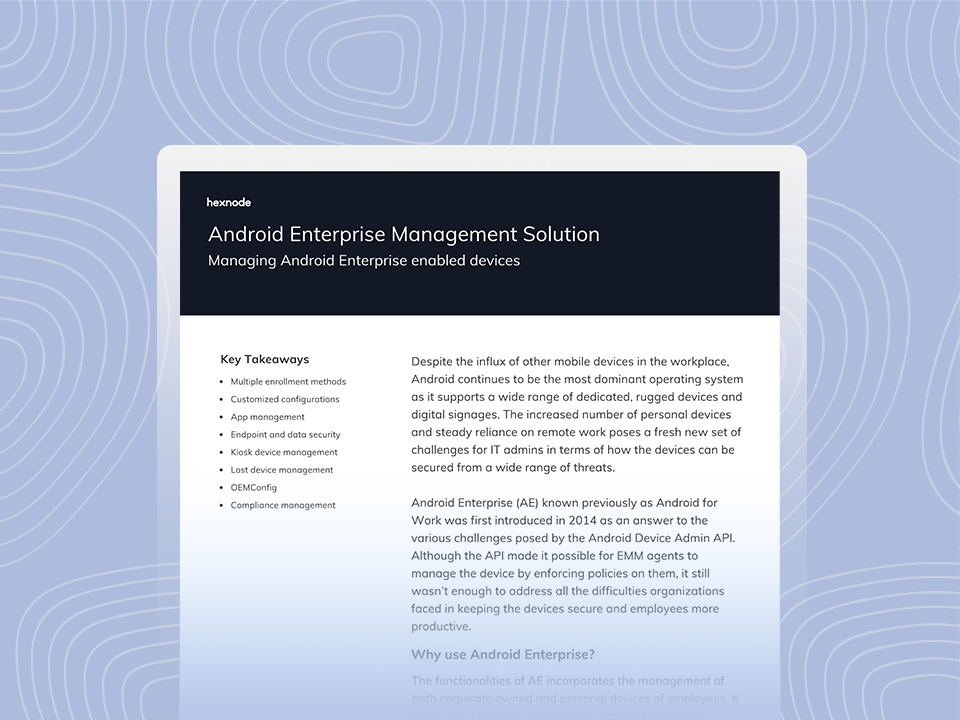Introducing Device Trust from Android Enterprise
A new way to verify and secure any Android device used for work, whether that device is managed by an EMM or not.

Get fresh insights, pro tips, and thought starters–only the best of posts for you.
Erum Rayn
Sep 8, 2025
8 min read

As businesses continue to embrace mobile-first strategies, staying current with Android OS updates is no longer just an option—it’s a necessity. Android’s latest iteration, Android 15, brings a suite of enhancements specifically designed to meet the evolving needs of enterprise IT teams.
Android 15 strengthens Google’s focus on enterprise by introducing improvements in security, management, and privacy—making it both IT-friendly and intuitive for users.
In this blog, we’ll walk you through the key enterprise-centric updates introduced in Android 15. From improved device management and granular security policies to intuitive user experiences for hybrid and frontline workforces, this release is packed with capabilities that IT admins can leverage to tighten control, increase productivity, and respect end-user boundaries.
Security has always been the foundation of Android Enterprise, and Android 15 deepens that focus with several meaningful updates aimed at strengthening both device-level and user-level protection.
With Android 15, IT administrators gain new capabilities to define which biometric modalities can be used on company-owned devices. This means organizations can now permit or block specific types of biometric authentication, such as facial recognition, iris scanning, or fingerprint authentication.
Why this matters:
Enterprises in highly regulated industries like finance, healthcare, or government can now restrict less secure biometric options (e.g., face unlock) while mandating more secure methods like fingerprint scans. This gives enterprises a tighter grip on authentication policies aligned with zero-trust strategies.
Another major leap is the enhanced support for secure key management. Android 15 extends the ability to handle cryptographic keys using hardware-backed keystores. This ensures that sensitive credentials and encryption keys are stored securely within tamper-resistant hardware components like the Trusted Execution Environment (TEE).
What’s more, Android 15 expands third-party certificate management capabilities. Enterprises can now delegate certificate provisioning to trusted certificate management apps, removing manual overhead and reducing potential errors in certificate lifecycle handling.
First introduced in earlier betas, the “Private Space” feature receives refinements in Android 15. This feature lets users create a locked, hidden container for personal apps on the same device used for work. IT administrators can’t access the data or apps in this space.
Use case:
In BYOD and COPE (Corporate-Owned, Personally Enabled) scenarios, users often worry about IT overreach. Private Space eases these concerns by physically and digitally separating personal content from enterprise oversight, enhancing employee trust and adoption of enterprise mobility programs.
Android 15 improves work profile features with significant user experience upgrades that reduce confusion and friction—two major barriers in enterprise mobility adoption.
Have you ever launched an app and found yourself unexpectedly in the wrong profile? Android 15 addresses this by introducing predictable app launching behaviour across personal and work profiles. Apps will now consistently launch in the appropriate profile, based on their configuration.
Why it’s important:
This seemingly small improvement significantly enhances the overall experience for employees juggling personal and work responsibilities on the same device. It reduces misdirected actions, duplicate logins, and user frustration.
Switching between personal and work profiles has always been a bit clunky—until now. Android 15 makes transitions smoother and faster, minimizing interruptions. This is particularly beneficial for hybrid workers and employees using COPE devices who toggle between modes frequently.
Work profile app icons are now more clearly marked with visual cues that indicate whether the app is operating in the work or personal environment. These subtle visual updates prevent accidental cross-profile usage and enhance awareness—especially for less tech-savvy employees.
For enterprise IT teams managing thousands of devices, Android 15 delivers new management APIs that offer more precision, control, and flexibility.
Android 15 introduces enhanced APIs that allow device policy controllers (DPCs) to enforce update policies with greater control. Admins can now better manage how and when system updates roll out to enterprise devices, aligning update timing with business-critical operations.
Example scenario:
Retail chains with point-of-sale (POS) Android devices can delay updates during peak business periods to avoid disruptions and schedule updates during maintenance windows.
Another notable update is support for fallback policies. When a device cannot apply a preferred policy (due to configuration issues or unsupported hardware), Android 15 lets IT enforce a secondary fallback policy to ensure that baseline security remains intact.
This provides resilience and continuity in policy enforcement, reducing the number of vulnerable or misconfigured devices in the fleet.
Following Android’s move toward delegated administration, Android 15 empowers IT to offload certificate management tasks to approved apps. This approach allows seamless integration with enterprise PKI systems and automates tasks such as certificate issuance, renewal, and revocation.
Why this matters:
Manual certificate management is prone to error and doesn’t scale well. Delegation ensures security policies remain intact across the device lifecycle without consuming IT bandwidth.

Download our datasheet to learn how Hexnode's Android Enterprise solution streamlines device management and security.
Download DatasheetThe new era of mobile work demands flexible and secure connectivity—and Android 15 delivers greater enterprise control over how devices connect.
As satellite connectivity becomes available on more Android devices, enterprises need ways to manage it. Android 15 introduces new controls that allow IT teams to enable or restrict satellite communications based on policy.
Example use case:
In defense, oil and gas, or emergency response sectors, satellite connectivity can be mission-critical. But for general enterprise use, it may raise concerns about unauthorized communication channels. With Android 15, enterprises can control this emerging capability on a per-device basis.
eSIMs are essential for global deployments and flexible network provisioning. Android 15 provides improved support for managing multiple eSIM profiles. Admins can switch between profiles or deactivate them remotely through UEM tools or the Android Management API.
Impact:
Organizations with distributed or traveling workforces can streamline mobile network provisioning, reduce roaming costs, and maintain compliance across regions.
When a new Android version drops, one of the biggest challenges for enterprises is ensuring that their internal and third-party apps continue to work without disruption.
Android 15 includes better tools and guidelines to help developers and IT teams test and validate applications ahead of deployment.
With developer previews and enhanced compatibility testing support, organizations can test their apps well before Android 15 becomes the default OS on managed devices.
These tools can simulate work profile behaviors, policy changes, and other enterprise scenarios to identify potential breakages early. This reduces the risk of downtime and helps IT deliver a seamless user experience during upgrade cycles.
For enterprise dev teams:
This update supports proactive application lifecycle management, ensuring that internal productivity and workflow apps remain functional and optimized post-upgrade.
Smooth deployment is critical when dealing with hundreds or thousands of enterprise endpoints. Android 15 provides new capabilities in the Android Management API and Android Enterprise Recommended (AER) program to streamline testing, validation, and rollout.
The Android Management API has been updated to offer:
This empowers IT to run more predictable deployments, detect issues early, and quickly adjust policies without deep device-level interventions.
The AER catalog now reflects Android 15 compatibility, helping organizations choose validated devices and solutions that fully support the latest OS features. This ensures that enterprises investing in mobility hardware can deploy with confidence, knowing devices will align with Android 15’s capabilities.
Android 15 marks a strong step forward in Android’s enterprise journey. It shows clear progress in addressing IT concerns while also improving employee experience—a dual priority that’s become essential in today’s mobile workforce.
In summary, Android 15 delivers:
As always, Google continues to invest in creating a secure, modern, and manageable platform that aligns with enterprise demands. Android 15 provides the tools, policies, and flexibility that IT leaders need—whether managing a few dozen devices or tens of thousands across the globe.
Now is the time for IT admins to begin testing Android 15, validate app compatibility, and prepare deployment strategies using the updated APIs and management tools.
Ready to upgrade?
If your organization is using a UEM platform like Hexnode, Android 15’s new capabilities can be integrated into your existing mobility strategy with minimal effort. Reach out to your UEM provider or device manufacturer to confirm support timelines and prepare your environment for the transition.
Stay secure. Stay productive. Stay Android Enterprise-ready.
Seamlessly manage and secure your devices with Hexnode's unified endpoint management platform.
Start Your Free Trial